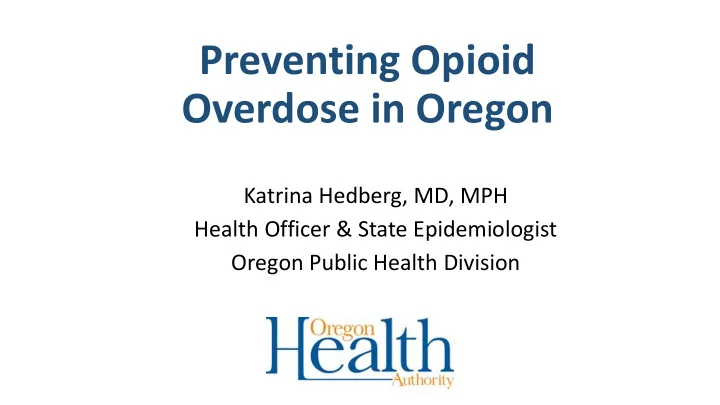

Preventing Opioid Overdose in Oregon Katrina Hedberg, MD, MPH Health Officer & State Epidemiologist Oregon Public Health Division
Death rates in middle-aged white Americans
Unintentional Drug Overdose Deaths — US 3
Drug overdose deaths in US; 2000-2014 2014: 47,055 drug overdose deaths (100 per day); 28,647 (60%) involved opioids
Amount Prescribed in US • 2012: 259 million prescriptions for opioid pain medications Enough for every adult in US to have a bottle of pills • Opioid dependency • 2013: 1.9 million persons diagnosed
Oregon Prescription Opioids: The Problem • Deaths in 2014 • 154 Oregonians died (prescription opioids) • Hospitalizations in 2013 • 330 Oregonians hospitalized • Cost of care was $9.1 million • 4,300 hospitalized patients had opioid use disorder • Misuse: 2012-2013 • 212,000 Oregonians (5% of population) self-reported non-medical use of prescription pain relievers 6
Drug overdose deaths, Oregon 2000-2014 7 Prescription opioids 6 Rate per 100,000 population 5 4 Heroin 3 2 Psychotropic (e.g. benzos) 1 2002 2004 2006 2008 2010 2012 2014 2000
Drug Overdose Deaths by Age, Oregon 2010-2014 12.00 Deaths per 100,000 residents 10.00 8.00 6.00 4.00 2.00 0.00 18-44 45-64 65-74 75+ Any Opioid Pharma Opioid Heroin Psychotropic 8
Opioid Overdose Deaths: 2010-14
Prescription Opioids by Age, Oregon Q1-2015 450.00 400.00 350.00 Per 1,000 residents 300.00 250.00 200.00 150.00 100.00 50.00 0.00 <18 18-29 30-44 45-64 65-74 75+ Age group (years) 10
Oregon Opioid Initiative Goals • Improve Population Health • Decrease drug overdose deaths • Decrease drug overdose hospitalizations/ ED visits • Decrease opioid misuse • Improve Care • Improve pain management practice, including use of alternative pain therapies • Increase medication assisted treatment for opioid use disorder • Decrease Health Care Costs 11
Spectrum of Interventions • Decrease amount of opioids prescribed • Prescribing guidelines, drug take-back, • Promoting use of non-opioid therapies for chronic pain • Increase availability of naloxone rescue for overdoses • Ensure availability of treatment of opioid misuse disorder • Use data to target and evaluation interventions 12
General Categories of Pain Acute Pain Pain lasting > 3 months, or past Chronic time of tissue healing non-cancer Prevalence: ~15% of US adults pain Cancer pain End of life pain 13
CDC prescribing guidelines • Initiate or continue opioid for chronic pain • Opioid selection, dosage, duration, follow up, discontinuation • Risk Assessment and addressing harms
OHA Opioid Initiative Activities • Opioid prescribing guidelines task force • Prescription Drug Monitoring Program • CCO Performance Improvement Project • Tool kit for CCOs • CDC grant funding for LHD and CCO partnerships in areas with high opioid overdose • Opioid website with links to resources • Local data to support policy: interactive data dashboard 15
Aligning Efforts • Opioid prescribing guidelines • Washington state, Oregon regional efforts (Southern Oregon OPG, Metro area, Central Oregon) • Health Systems guidelines • Legislative activities: HB 4124, Good Samaritan Law • Hospital Metrics Committee • Regional summits • Dept of Justice grants 16
Balance Needs Protect & promote pain management Privacy & Inform Security clinicians Guidelines/ Honor Control PDMP/ legislative diversion intent Regulation Public Inform education public prevention policy Increase practice SA treatment referrals
Questions? Katrina Hedberg, MD, MPH State Health Officer Public Health Division, Oregon Health Authority Katrina.Hedberg@state.or.us Website: healthoregon.org/opioids 18
Recommend
More recommend